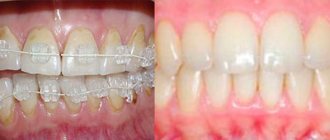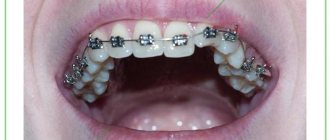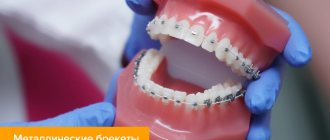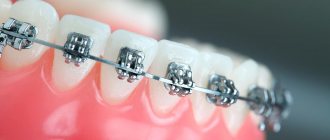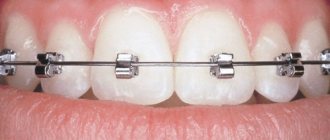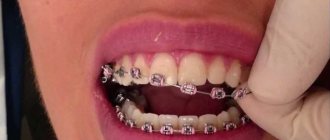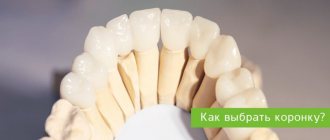Everything you would like to know about correcting your bite and straightening your teeth with braces.
Let's be honest: in modern realities, a beautiful smile is the norm, and it is necessary to get rid of dental imperfections. But, having set such a goal, it is desirable to have reliable information about existing methods and upcoming tests. We tried to collect in one article all the most important things about braces in order to save you from having to look for answers on your own on the Internet, where the truth is mixed with myths and advertising fluff.
Important!
In the article, prices are indicated for St. Petersburg and the Leningrad region.
How are braces different from aligners?
This question worries many: is it possible to pay more, but get by wearing transparent removable aligners? The truth is that nice aligners can only cope with minor problems (for example, with one tooth that has grown incorrectly), but only fixed structures - those same “ugly braces” - can create an orthodontic load to shift the dentition.
As for cap-aligners, to achieve the effect, it is recommended to wear them at least 22 hours a day, removing them only during meals. As practice shows, a person often violates such rules by being distracted, forgetting, or simply allowing himself some indulgence. Strictly speaking, aligners are not intended to correct bites, and if they are positioned as such on the clinic’s website, it is better to turn to other specialists.
And the financial point: you will have to pay not more for the aligners, but much more, because during the treatment period they need to be changed at least 15 times (and sometimes much more), so the average minimum cost of correction with the help of aligners should be considered an amount of about 250- 300 thousand rubles.
What are internal braces and when are they placed?
Internal, or lingual, are braces that are placed on the inside of the teeth, making them invisible to others. As a rule, metals are used as a material for the manufacture of internal bracket systems in order to achieve maximum structural strength.
When are internal braces placed? Lingual systems can be used for various malocclusions and any degree of curvature of the dentition - even in cases where the vestibular apparatus (attached to the front surface of the teeth) is powerless. In general, the principle of treatment with internal braces does not differ from the procedure for correcting bites using traditional orthodontic systems. The only difference is that the treatment process will be visually invisible.
When internal braces are placed:
- Gaps between teeth
- Uneven teeth
- Bite pathologies
- Crowded teeth
- Underdevelopment of the jaws
- Facial asymmetry
- Preparation for prosthetics
- Anomalies of individual teeth
The advantage of installing lingual braces on teeth: internal systems are much less likely to cause gum problems than vestibular structures.
Along with their advantages, lingual braces have a number of serious disadvantages. Their installation itself is a complex and lengthy process that requires considerable patience from the patient. After fixing the braces on the inside, you need to be prepared for fairly long-term problems with diction, and possible tongue rubbing. Internal braces require especially careful care, which consists of 10 minutes of cleaning after each meal using orthodontic and single-tuft brushes, a brush and special dental floss. Finally, the cost of lingual appliances is much higher than all other orthodontic structures.
In what cases are internal braces not installed?
- Jaw too narrow
- Gum disease (installation possible after treatment)
- Severe crowding
- Short tooth crowns
- Pathology of the temporomandibular joint
- Severe allergic diseases
- Age under 11 years
Individual and standard internal braces
Along with standard sets of lingual devices, there are individual internal braces. Unlike template braces, which are mass-produced at a factory and cannot guarantee absolute accuracy, in individual devices all elements are created for a specific patient, taking into account the angles of each tooth. Such internal braces, as a rule, are smaller in size and are more effective in terms of timing and predictability of the result, as they allow a more targeted impact on the problem. In addition, individual braces on the inside of the dentition can shorten the patient’s adaptation period and somewhat reduce the discomfort from wearing the structure - due to its smooth shape and small thickness. But they cost accordingly - from 300,000 rubles excluding the cost of treatment.
Installation of internal braces
Installation of lingual braces is a labor-intensive and complex process lasting up to 4 hours, which requires a high level of professionalism from the specialist and patience on the part of the patient. Moreover, before starting orthodontic treatment, complete sanitation of the oral cavity is necessary: strengthening the gums, getting rid of tartar and plaque, treating teeth affected by caries. The procedure for fixing braces to the inside of the teeth takes place in several stages:
- The patient is sent for an x-ray.
- A plaster cast is taken of the patient's jaw.
- A treatment plan is drawn up.
- Based on the impression, a model is made that completely replicates the dentition; brackets are attached to it and connected to each other with a bridge.
- The finished bracket system is transferred to the teeth.
- Corrections of the bracket system are carried out regularly.
- After removing the orthodontic structure, the patient is fitted with a retention device, which is needed to fix the teeth in the desired position and secure the result.
If individual internal braces are chosen for treatment, the period of time from the first appointment with a specialist to the installation of the system is extended (1.5-2 months instead of 2-3 weeks), because the production of a unique device is a longer process than the production of braces using a template.
How long do internal braces last?
The duration of treatment with lingual braces is individual for each patient and depends on many factors:
- The severity of the malocclusion
- Presence of crowding (crowding may require tooth extraction)
- Age of the patient (the problem can be corrected at an early age faster)
- Keeping the patient organized – following the rules for caring for braces
- Oral health
- Manufacturer of the device
On average, the duration of treatment with internal lingual braces is the same as in the case of vestibular systems, ranging from 18 to 30 months. Depending on the complexity of the problem, this period can be reduced to a year or increased to three years. During the entire period of orthodontic treatment, internal braces cannot be removed, otherwise the teeth will return to their original position.
How much do internal dental braces cost?
Lingual braces are much more expensive than vestibular braces, which is dictated by the complexity of manufacturing and the labor-intensive installation of the device. When estimating how much internal dental braces cost, you need to take into account that the price consists of the cost of the procedure, the quality of the orthodontic system and the level of the clinic. Installing an internal brace system made from a template on both jaws will cost, on average, 200,000 rubles. At the same time, standard braces are quite large, which makes it difficult for the patient to adapt to them, reduces the level of comfort while wearing them and causes problems with diction. These problems can be partially solved with individual braces, but they will cost more than 300,000 rubles.
Installing and wearing braces: does it hurt?
When installing braces, the vast majority of patients do not experience any noticeable pain, but discomfort certainly appears, and you will have to get used to the braces - for some faster, for others longer, on average - 1-2 days. The exception is, perhaps, people with a very low pain threshold or with increased impressionability - it is from them that the myths about the pain of installing and wearing braces come.
In fact, sometimes there is irritation of the mucous membranes of the lips and cheeks. To solve this problem, a special wax is used, which the doctor will definitely suggest after installation.
Braces for crowns, veneers, implants
Crowns are not a contraindication to orthodontic treatment. The best option for installing braces on crowns is a metal system. It will provide reliable adhesion to the artificial material of the prosthesis. If you need to install a brace system on the teeth that serve as support for the bridge, the doctor will simply remove the prosthesis and put temporary plastic crowns on the patient for the period of treatment.
As for veneers, if they are already on the teeth, this will not be a contraindication to installing a brace system. However, it is still better not to install veneers before braces, especially taking into account that an incorrect bite is, in principle, a contraindication to veneering.
With an implant, it is already more difficult to correct the bite with braces - the artificial root sits firmly in the bone and is not able to move except upward. If possible, it is better to correct the curvature of the dentition before installing an artificial root. However, if implants are already in place, orthodontic treatment can still be planned and successfully carried out.
I’ll take off my braces, a couple of years will pass, and my teeth will return to their place... is this true?
But this is true - but from the practice of past years! Now, after removing braces, the dentition is secured using a special non-removable retainer apparatus; previously this was not always done - hence the accumulated complaints. Today, orthodontists are required to install such a device.
A retainer is a thin wire that is installed on the inside of the front teeth and prevents them from moving apart. And this is for the rest of your life, but you shouldn’t worry: the delay is imperceptible, those around you don’t see it, and if it breaks, it’s easy to fix—just don’t delay your visit to the doctor.
Another problem is more pressing: sometimes, after straightening the dentition, previously hidden aesthetic defects (for example, different lengths of teeth) become noticeable. In this case, you will really have to resort to restoration or buy expensive veneers.
Important!
The orthodontist must notice such defects and warn the patient before starting treatment.
How do braces work?
The system is an elastic arch made of high-strength material, which is installed in the grooves of the so-called locks (this is what we see if the installation was on the outside of the teeth). Braces can be fixed to the inner or outer surface of the teeth, but the principle of operation still remains the same.
The main action occurs thanks to the elastic arc. It repeats all the curves and irregularities of the teeth, but always strives to return to its original, “correct” position, which means it puts pressure on the teeth and, as it were, “pulls” them along with it in the right direction. As soon as the feeling of pressure on the teeth disappears, we can say that the correction was successful.
As a rule, braces are worn for about a year, and they can be placed on teeth that have completed their growth, that is, after 14 years. While wearing it, the doctor can make corrections to reduce or increase the force of pressure of the arc on the teeth. It is believed that with age, teeth become increasingly difficult to correct. How much does it cost to get braces for an adult? The price depends on the type of braces.
Do braces damage enamel and lead to caries?
No, the tight fit of the braces completely eliminates the penetration of food debris and microbes into the tooth; Dental enamel glue used in practice is harmless, moreover, it contains the useful element fluorine. The brace-lock even protects the tooth in a certain way.
But improper care of braces is really fraught with trouble: oral hygiene after installation of an orthopedic structure requires more attention and responsibility due to the increased accumulation of plaque. And where there is plaque, there is caries!
Teeth after braces
Many patients fear the negative consequences of braces. It is known that dental braces complicate oral hygiene procedures. However, following the doctor’s instructions for dental care during the treatment period will help avoid exposure to carious bacteria. If caries does appear, in most cases the specialist will be able to carry out treatment without disturbing the braces.
When removing sapphire or ceramic braces, damage to the enamel is possible - during the procedure they can crumble, which significantly complicates the orthodontist’s work. If damage occurs, the defect can be easily corrected with a small restoration.
Is it necessary to use additional products to clean braces?
On forums (and sometimes in the recommendations of “experts”!) there are numerous additional products that supposedly make oral hygiene easier in the presence of braces (rinses, ultrasonic brushes, etc.)
In fact, with a responsible approach, it is quite possible to get by with three basic tools (toothbrush, dental floss, brush). In this case, you should not rely on someone else’s opinion. The quality of care will be assessed by a doctor who conducts regular examinations, and he will also recommend additional remedies, if necessary.
The sixth disadvantage of lingual braces is the intimate side
Doctors are tactfully silent about this drawback of lingual braces. But it exists. And it causes a lot of problems for owners of lingual structures. This is a continuation of the minus of point #3 - injury. But not the tongue - but injury by parts of the internal braces to the mucous membrane of the sexual partner during intimate caresses: causing micro-scratches with possible infection of the wounds due to insufficient hygiene of the lingual braces. Such statistics are periodically published in the European and American press, where they really and openly talk about it.
Is there a need to give up your usual food?
As a rule, when installing a brace system, the doctor will actually announce “forbidden” foods, and this list looks quite depressing (cookies, chips, seeds/nuts, crackers, chewing gum, pizza, chocolate bars, etc. - everything that can stick to the structure , creating conditions for the proliferation of microbes, or damaging it). But in this case, the doctor’s recommendations should be approached in a differentiated manner: there is a clear reinsurance here, the only thing that is actually required from the patient is caution.
Is it true that sapphire braces are the best?
Sapphire braces are much more expensive than iron braces, but their advantages do not lie in the effectiveness of treatment. Moreover, in reliability they are inferior to metal ones. But on the teeth, such brace systems look much more aesthetically pleasing, since transparent brace locks are almost invisible.
Let us clarify: the precious natural stone sapphire has nothing to do with the production of such briquettes; we are talking about artificially grown crystals.
By the way, there are also cheaper transparent braces - ceramic (much more expensive than metal ones, but not as expensive as sapphires) and plastic designs. Only the former are too fragile and unstable in relation to food dyes (can lead to yellowing of teeth), and the latter are intended only for short-term use.
How is the installation going?
Installation work takes place in several stages. A good dentist takes impressions to make control models in order to further monitor the progress of bite treatment. Then he installs special separation rings that slightly move the teeth apart. The doctor applies an etching gel to the areas where the clear braces are located. After a certain time, it is washed off and the enamel is dried. Then a fixing adhesive bond is applied, which is illuminated with a photopolymer lamp. Glue is also applied to each bracket, after which the orthodontist accurately determines the position of the transparent element, pressing it to the tooth. After the specialist fixes all the braces, he will insert an arch into their grooves, which he will secure with transparent ligatures (rubber bands).
Sapphire braces are much more difficult to fix than metal ones, since they almost merge with the surface of the tooth. Therefore, such systems should be installed only by experienced specialists with extensive practical experience working with transparent orthodontic structures.
How much do simple metal braces cost?
The remarkable cheapness of hardware is just a myth supported by some clinics. Indeed, by indicating the cost of one element of the braces system, they create the illusion of affordable treatment, but the patient should understand that the treatment process involves paying for braces, dental materials, multiple visits to the doctor and various procedures, including removal of the system at the end of treatment - and all this will cost at a very decent amount.
On average, the price of a course of treatment in an ordinary case (healthy teeth, simple defect) is 150-170 thousand rubles. (and this does not take into account preliminary professional teeth cleaning and diagnostics). If you have tooth decay and/or gum problems, you should add the cost of treatment or surgery to this amount. After removing the braces, you will have to pay for the installation of retainers, and, if necessary, restoration or installation of veneers.
Important!
There is no point in finding out the cost of braces over the phone, since each case is individual; choose the clinic where they will tell you the amount of all necessary procedures and operations - so to speak, the amount of “turnkey” treatment.
Types of bracket systems
Some people don’t attach importance to the presence of a metal device in the mouth - back in the 90s, Cindy Crawford not only wore dental braces, but even starred in them in an advertising campaign for Pepsi Cola. For those who have chosen external orthodontic braces, but prefer not to advertise the treatment, there are other options.
Types of braces depending on material
- Plastic: the most budget braces - from 20,000 rubles. It is the plastic design that has become not just a device for dental treatment, but also an accessory that complements the image. Unfortunately, it also has many disadvantages: plastic is not the most durable material, in addition, such dental braces change color under the influence of coloring products.
- Metal: The most durable of all braces for straightening teeth, but they are not suitable for people with metal allergies. A steel system will cost 60,000 - 80,000 rubles, a titanium system - from 80,000 to 100,000 rubles. In terms of aesthetics, this is not the most advantageous design.
- Ceramic: highly aesthetic, matched to the color of the enamel, does not cause allergies, but is less durable than metal. In Moscow, the cost of ceramic braces is 40,000 - 70,000 rubles.
- Sapphire: the most aesthetic of all options. They look very impressive in the light, but if the patient’s teeth have a yellowish tint, you should carefully consider whether sapphire braces are needed, as they will stand out strongly. Also quite fragile. The cost of sapphire structures is 100,000 - 150,000 rubles.
What are the advantages of ligature-free braces? And do they exist?
Ligatures are wires or elastic rings with the help of which bracket locks are attached to the arch. In ligature-free bracket systems, the arch is inserted into a special clip, and ligatures are not needed.
Self-ligating braces (also known as self-ligating braces) have been aggressively promoted for some time, causing their prices to rise. However, time and practice have shown that the advantages attributed to such systems are absent (including the myth about the special strength achieved due to minimal friction of the archwire with the bracket locks).
Price for braces in Moscow
As a rule, the cost of braces in Moscow is formed from the price of the system itself, as well as the total costs of installation and further treatment. The cheapest braces are, of course, metal. Their price starts from 50,000 rubles. Relatively inexpensive ceramic systems that cost about 75,000 rubles. The cost of a sapphire bracket system starts from 85,000 rubles. You need to be careful here, as ceramics are sometimes passed off as sapphire. The most expensive will be lingual systems, especially if they are made to order, their approximate price starts from 100,000 - 150,000 rubles. When figuring out the cost, be sure to ask what is included and what services will need to be paid additionally. It happens that the initially low price of braces increases significantly during the treatment process. However, when choosing an orthodontist and a braces system, you should not focus solely on cheaper or more expensive; remember that poor-quality orthodontic treatment is fraught with a lack of results and the occurrence of a number of complications.
| A country | Manufacturer | Manufacturing materials | Price |
USA | 3M Unitek | Metal braces | from 25,000 rubles |
| Ceramic braces | from 70,000 rubles | ||
| Sapphire braces | from 80,000 rubles | ||
| Ormco | Metal braces | from 20,000 rubles | |
| Ceramic braces | from 45,000 rubles | ||
| Sapphire braces | from 50,000 rubles | ||
| American Orthodontics | Metal braces | from 40,000 rubles | |
| Ceramic braces | from 70,000 rubles | ||
| Sapphire braces | from 50,000 rubles | ||
| Ortho Technology | Metal braces | from 15,000 rubles | |
| Ceramic braces | from 35,000 rubles | ||
| Sapphire braces | from 40,000 rubles | ||
| The Dentsply GAC | Metal braces | from 20,000 rubles | |
| Ceramic braces | from 30,000 rubles | ||
Germany | TOP-Service für Lingualtechnik GmbH | Gold-platinum alloy braces (lingual only) | from 175,000 rubles |
| Forestadent | Metal braces | from 30,000 rubles | |
| Ceramic braces | from 60,000 rubles | ||
| Sapphire braces | from 90,000 rubles | ||
Korea | HT Corporation | Metal braces | from 20,000 rubles |
| Sapphire braces | from 30,000 rubles | ||
Italy | SIA Orthodontic | Metal braces | from 20,000 rubles |
| Ceramic braces | from 25,000 rubles | ||
Are lingual braces worth their high cost?
The most expensive lingual brace systems today are much more expensive than expensive sapphire braces; correction costs the patient up to 500 thousand rubles. But progressive doctors have already abandoned this solution, the only advantage of which is invisibility to others due to installation on the inside of the teeth.
This only advantage is greatly diluted by numerous disadvantages: adaptation to such systems is more difficult and longer (up to several months), the likelihood of injury to the tongue is high, the effect on diction is more pronounced, the requirements for caring for them are stricter, and recovery in case of peeling is more difficult.
Popular models
There are several popular models of invisible braces on the Russian market:
- Incognito. Lingual braces for correcting malocclusion are highly effective and aesthetically pleasing. The plates are made of pure gold and cast according to individual bite characteristics. Gold in the product dramatically reduces the risk of an allergic reaction and does not oxidize;
- In-Ovation L. Ligature invisible bracket systems with low thickness and smoothed edges of the plates. The products solve the problem of complex bite defects, as they have the ability to independently change the degree of tension of the metal arch;
- WIN. Vin's products are considered an analogue of Incognito, but without the use of gold in the composition. Low profile eliminates chafing of enamel and mucous membranes;
- STb. Ligature type of invisible braces for correcting teeth with small crowns. Wearing period is limited to one year.
There are other types of lingual braces, as well as external structures that are invisible when smiling and talking. These braces match the color of the tooth enamel as closely as possible. These include ceramic or sapphire braces.
The approximate cost of invisible braces varies from 140 to 500 thousand rubles. The final price for invisible braces depends on the extent of orthodontic treatment.
The result of the correction is a perfect smile in a short time. The total duration of wearing the products is 1-1.5 years.
Is it possible to put braces on only one jaw?
Many patients are perplexed: why, if, for example, 1-2 upper teeth are displaced, why install a system on the entire jaw. The desire to minimize inconvenience and costs is quite understandable, but the realities are different: teeth are straightened not by braces, but by the device that is attached to them, and the force of its influence must be uniform, which requires fixation on the entire dentition. Otherwise, the “crooked” tooth will fall into place, but will inevitably push others out of the row.
The concept of a “partial bracket system,” however, exists - such systems are installed on one jaw and cost half as much. However, such a correction is possible only in the absence of bite pathologies and strict symmetry of the teeth of the upper and lower jaws, when there is only a slight curvature of 1-2 teeth (according to statistics, in orthopedic practice there are no more than 5% of such cases).
How much does it cost to put braces on your teeth: price for all procedures
To understand the final cost of treatment, you need to understand what it comes from. And this happens in a complex manner, including the price of the system itself and the doctor’s work. So, let's take a closer look at how much it costs to get braces for an adult in Moscow. All treatment consists of the following stages:
- Consultation, during which the doctor will talk about different systems for correcting bites, treatment conditions, timing and how much it costs to install braces in Moscow.
- The diagnostic stage, at which the doctor examines the teeth, takes a picture, and based on these data, a treatment regimen and the type of braces are selected individually.
- The preparatory stage, during which all diseased teeth are healed, the oral cavity is completely sanitized, and the enamel is deeply cleaned. How much does it cost to get braces for an adult at this stage? That's right, we add the cost of dental treatment.
- Taking impressions for individual production of the system and visualization of the result.
- Making braces. Above we described what the price depends on. How much does it cost to get braces on one jaw? Installing braces is a rather labor-intensive and complex process, so the price for this design will be set for you by the doctor himself after a consultation.
- Correction. Depending on the system, you will have to visit the doctor once every 1-3 months, and each visit will be paid separately.
In addition to these mandatory steps, during treatment it may be necessary to replace deformed or broken parts; this is paid for by the patient himself. The exception is a manufacturing defect.
Is it possible to install and wear braces during pregnancy?
Pregnancy is a period of serious changes in a woman’s body, including, among other things, bone tissue, tooth roots and bone plates. This is definitely a stressful condition, which should not be aggravated.
Thus, it is strictly forbidden to begin correcting the bite if there are plans to expand the family or in the process of bearing a child, and if an unplanned pregnancy occurs during the current course of correction, the brace system must be removed as quickly as possible.
Advantages and disadvantages
Advantages of lingual braces over classic options for correcting malocclusion:
- correction of severe curvature in a short time;
- There are different types of lingual braces;
- no risk of demineralization of enamel on the outer surface of the tooth;
- carrying out treatment even in adulthood;
- aesthetics for the entire period of bite correction;
- wearing comfort for children and adults.
Despite their uniqueness, installing invisible lingual braces has a number of disadvantages:
- the correction procedure is not carried out in all clinics;
- high price for lingual products;
- complex installation technique due to the characteristics of the teeth and the position of invisible braces;
- temporary change in diction;
- age restriction - correction is not carried out in children under 12 years of age.
Treatment with lingual braces for severe malocclusion pathology takes longer. There are cases of damage to the tongue and oral mucosa from the inside. Patients also note an increase in salivation.
There are different types of invisible braces, which are classified according to the material used and the type of model.
At what age is it better to start correcting a child’s bite?
The optimal age to begin orthodontic treatment is after the formation of the bite is completed (usually at 11-12 years). Why shouldn’t you follow the recommendations of some clinics that invite patients aged 7-9 years for treatment?
The answer is provided by the results of a scientific study of tooth growth and bite formation in children, which showed that the curvature of the dentition during the period of replacement of milk teeth with permanent teeth is not indicative and does not require intervention, since the dentition gradually straightens naturally (for example, the lateral teeth eliminate the gap between In front of them).
This, of course, does not mean that you should not visit a pediatric orthodontist if you see reasons for concern. The primary bite is formed by the age of 3-4 years, and from this age you can consult with specialists. But you shouldn’t start treatment unless there are good reasons for it.
Final general recommendation:
the patient is not obliged to agree in everything with the doctor’s opinion if it seems erroneous. Consult another clinic, get an alternative opinion, because we are talking about your health, about your appearance, about your money, finally. Get treatment from those you trust!
Indications for installation
Internal braces are installed to correct uneven teeth and malocclusion by applying pressure to the side of the teeth that is hidden from prying eyes. Orthodontic treatment with such brace systems is considered effective and very popular among patients of dental clinics.
Lingual systems, like other orthodontic devices, are installed according to indications, including:
- curvature of the dentition or individual teeth;
- presence of gaps between teeth, incl. at the front;
- malocclusion, incl. deep bite;
- underdeveloped jaw, etc. (disorder of development, size).
In each individual case, the orthodontist offers one or another treatment option only after examining the oral cavity and obtaining x-rays of the jaw. Internal braces do not differ from other systems in their effect on the dentition; the choice is always up to the patient. When making a decision, the aesthetics and invisibility of such an orthodontic appliance are of decisive importance. The main advantage is that such braces are suitable for most people, and if there are contraindications, the doctor will recommend another method of therapy.
